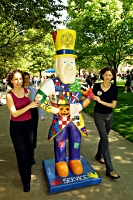 Wake Forest University students, faculty, staff and volunteers celebrated the public kickoff of the university’s capital campaign April 26 with a “Parade of Deacons” featuring 7-foot-tall, fiberglass versions of Wake Forest’s Demon Deacon mascot.
Wake Forest University students, faculty, staff and volunteers celebrated the public kickoff of the university’s capital campaign April 26 with a “Parade of Deacons” featuring 7-foot-tall, fiberglass versions of Wake Forest’s Demon Deacon mascot.
Wake Forest announced that it has set a $450 million goal for the major fundraising effort, called “The Campaign for Wake Forest University: Honoring the Promise.” The university has raised $264 million, already.
The university’s Reynolda Campus has raised $140 million of the goal, while the Wake Forest School of Medicine has raised $124 million. The medical school’s campaign, which was already underway, is now a part of Wake Forest’s university-wide campaign. The Reynolda Campus is expected to raise approximately two-thirds of the overall campaign goal.
The Wake Forest campaign is designed to raise endowment for student scholarships and faculty support, as well as to meet other university needs, such as ongoing operating expenses.
Leading up to the April 26 kickoff of the public phase of the university-wide campaign, students and others at Wake Forest have been designing extraordinary versions of the famed Deacon. In striking contrast with the traditional Deacon, known primarily for his simple black suit and top hat, many of these Deacons were decorated with bright colors and images unlike any ever seen on the mascot.
One Deacon’s coat, for instance, features an image of Wake Forest’s Wait Chapel taken from a poster promoting last fall’s Presidential Debate at the university. Another Deacon is covered in camouflage paint from hat to boots.
“We thought this would be a fun way to bring the Wake Forest community together and celebrate the start of a major new phase in the capital campaign,” said Jennifer Richwine, director of campaign programs.
“We want the parade of Deacons to create an awareness of the capital campaign among those many people so important to the university,” Richwine added. “The campaign is geared toward people, particularly students and faculty, and we want these people and others to be able to participate.”
In all, 19 Deacons were custom-designed for the kickoff. The challenge of designing the Deacons was accepted by graduate and professional schools at the university, as well as the Athletics department, the Alumni office, the College Book Store, the Army ROTC program, the art department, student organizations, and individual students.
All of the Deacons, accompanied by designers, were paraded on the sidewalk on University Plaza (the university’s quad). Spectators included students, faculty and staff, as well as university volunteers on campus for a Volunteer Leadership Conference. Volunteers include members of the board of trustees, boards of visitors and other groups.
The idea of creating the specially designed Deacons for the kickoff was inspired by “Cow Parades” in Chicago and New York City, in which life-size, fiberglass cows were put on public display and later auctioned to raise money for charity.
Following the parade, the Deacons will be positioned in various buildings throughout the university. Next fall, at Homecoming, they will be auctioned to university alumni, parents and friends.
The university-wide capital campaign is expected to continue until 2006. The initial phase of the Reynolda Campus campaign began about 18 months ago, when university representatives began meeting privately with a number of prospective major donors, including individuals, foundations and corporations.
University leaders anticipate the campaign playing an important role in preserving the accessibility of the university to students dependent on financial assistance.
“To ensure that our doors remain open to students from all economic backgrounds, we must increase the number and value of scholarships currently offered, especially to middle-class students,” said Wake Forest President Thomas K. Hearn Jr. “And to ensure that those students do in fact have a superior academic experience, we must increase faculty support to attract and retain the very best teacher-scholars possible.”
Categories: Events, University Announcement
Headlines
Wake Forest in the News
Wake Forest regularly appears in media outlets around the world.




